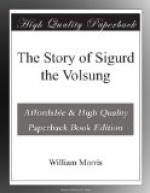The story of Sigurd is important to English people not only for its wondrous beauty, but also on account of its great age, and of what it tells us about our own Viking ancestors, who first knew the story.
The tale was known all over the north of Europe, in Denmark, in Germany, in Norway and Sweden, and in Iceland, hundreds of years before it was written down. Sometimes different names were given to the characters, sometimes the events of the story were slightly altered, but in the main points it was one and the same tale.
If we look at a map of Europe showing the nations as they were rather more than a thousand years ago, we see the names of Saxons, Goths, Danes, and Frisians marked on the lands around the Baltic Sea. Those who bore these names were the makers of the tale of Sigurd. The name of the Saxons is, of course, the best known to us, and next in importance come the people we call Danes, or Northmen, or Vikings, who attacked the coasts of the Saxon kingdoms in England. The Saxons came from part of the land that is now known as Germany, and the Vikings from Denmark and from Scandinavia.
A third important tribe was that of the Goths, who dwelt first in South Sweden, and then in Germany.
All these people resembled one another in their way of life, in their religion, and in their ideas of what deeds were good and what were evil. Their lands were barren—too mountainous or too cold to bring forth fruitful crops, and their homes were not such as would tempt men never to leave them. So, though they built their little groups of wooden houses in the valleys of their lands, and made fields and pastures about them, these were often left to the care of the women and the feeble men, while the strong men made raids over the sea to other countries, where they engaged in the fighting which they loved, and whence they brought back plunder to their homes. North, South, East, and West they went, till few parts of Europe had not learnt to know and fear them.
Their ships were long and narrow, driven often by oars as well as sails, and outside them, along the bulwarks, the crew hung their round shields made of yellow wood from the lime-tree. The men wore byrnies or breast-plates, and helmets, and they were armed with swords, long spears, or heavy battle-axes. They were enemies none could afford to despise, for they had great stature and strength of body, joined to such fierceness and delight in war that they held a man disgraced if he died peacefully at home. Moreover, they knew nothing of mercy to the conquered.
Courage, not only to fight, but also to bear suffering without impatience or complaint, and the virtue of faithfulness were the qualities they most honoured. To be wanting in courage was disgraceful in their eyes, but it was equally disgraceful to refuse to help kinsfolk, to lie, to deceive, or to desert a chief.
If they put their enemies to death with fearful tortures, they did not treat them more severely than the traitors they discovered among themselves, and if they had no pity for those they conquered, yet they knew well how to admire great leaders, and how to serve them faithfully. But we can best realise their ideas on these matters by considering their religion and their stories.




